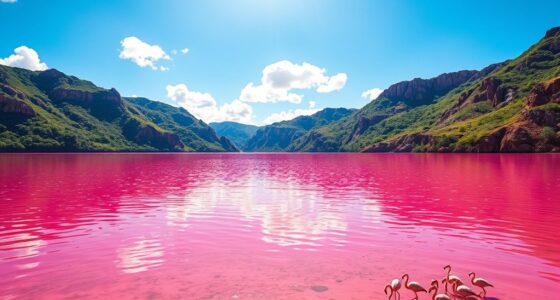The return of beavers across Europe stands out as one of the most successful rewilding stories, transforming landscapes and restoring natural ecosystems. By building dams, they create wetlands that support diverse plants and animals, reduce erosion, and improve water quality. Their activity boosts landscape resilience and helps combat climate change through carbon storage. This remarkable comeback highlights nature’s resilience and benefits ecosystems on a large scale. Keep exploring to discover how beavers continue to shape and restore the environment.
Key Takeaways
- Beavers act as ecosystem engineers, creating wetlands that support biodiversity and improve landscape resilience across Europe.
- Reintroduction of beavers enhances natural water management, reduces erosion, and restores degraded ecosystems.
- Beavers’ dam-building activity promotes climate mitigation by trapping carbon and filtering pollutants.
- Their return demonstrates successful rewilding efforts, showcasing nature’s resilience and ecological restoration.
- Beaver reintroduction supports diverse habitats for insects, amphibians, birds, and other wildlife, strengthening ecosystem health.

Rewilding efforts across Europe have seen remarkable success with beavers, often called nature’s engineers, transforming landscapes and restoring ecosystems. You might not realize it, but beavers play a crucial role in shaping their environment, creating a cascade of ecosystem benefits that extend far beyond their immediate surroundings. When beavers build dams, they slow down water flow, which helps reduce erosion and filter pollutants, leading to cleaner rivers and lakes. These structures also create wetlands that serve as essential habitats for countless species, supporting biodiversity and promoting habitat restoration.
Beavers transform landscapes by building dams that reduce erosion, filter pollutants, and create vital wetlands for diverse species.
As you observe these rewilded areas, you’ll notice how beaver activity fosters a more resilient landscape. The ponds and wetlands they form act as natural sponges, absorbing excess water during heavy rains and releasing it slowly during droughts. This natural regulation of water levels benefits not only aquatic life but also nearby terrestrial habitats, ensuring they remain healthy and productive. The increased moisture encourages diverse plant growth, which in turn provides food and shelter for a variety of animals. This cycle of habitat restoration demonstrates how beavers are restoring balance to ecosystems that have been degraded by human activity or climate change.
The ecological benefits extend further. Beaver-created wetlands support insects, amphibians, and bird species that rely on aquatic environments for breeding and feeding. By fostering these rich habitats, beavers help maintain the complex web of life that sustains entire ecosystems. Additionally, the trees and shrubs that thrive in these wetlands stabilize soils and prevent further erosion, reinforcing the habitat restoration process. You’ll see how these natural engineers help create landscapes that are more resilient to environmental pressures, effectively turning degraded areas into thriving ecosystems.
Furthermore, beaver activity can lead to increased carbon sequestration. The expanded wetlands and lush vegetation that develop around their dams trap carbon dioxide, contributing to climate change mitigation efforts. This highlights the broader significance of beaver reintroduction—not just for local habitat health but also for global ecological stability. Ecosystem restoration benefits are amplified when beavers are supported as keystone species, emphasizing their critical role in maintaining ecological balance. As you witness these positive changes, you’ll understand how the return of beavers is a cornerstone of successful rewilding projects across Europe, helping to repair ecosystems and restore natural processes that benefit all species, including humans.
In essence, the reintroduction of beavers exemplifies how targeted conservation efforts can generate extensive ecosystem benefits. Their ability to engineer landscapes and promote habitat restoration underscores their importance as keystone species. By supporting these initiatives, you’re contributing to a future where ecosystems are healthier, more balanced, and better equipped to face environmental challenges. The return of beavers isn’t just a story of animal recovery; it’s a testament to nature’s resilience and the transformative power of rewilding.
Frequently Asked Questions
How Do Beavers Impact Local Agriculture and Land Use?
Beavers impact your land use and agriculture by creating wetlands that enhance biodiversity and water quality. While some may worry about flooding or crop damage, beavers also offer agricultural benefits through natural land management strategies, reducing the need for costly infrastructure. Their dam-building activity helps control water flow, which can prevent erosion and improve soil health, making them valuable allies in sustainable land management.
What Are the Most Effective Methods for Monitoring Beaver Populations?
Monitoring beaver populations is like keeping a finger on the pulse of a thriving ecosystem. You should use a mix of tracking techniques, such as camera traps, trail surveys, and acoustic monitoring, to gather detailed data. Conduct regular population surveys to track changes over time. Combining these methods ensures you get an accurate picture of beaver numbers and health, helping you manage and protect them effectively.
How Do Beaver Activities Influence Water Quality and Downstream Ecosystems?
You’ll notice that beaver activities, like building dams, markedly improve water quality. Beaver dams create slow-moving water, which promotes water filtration by trapping sediments and pollutants. This process enhances downstream ecosystems by providing cleaner water, supporting aquatic life, and maintaining healthy habitats. As beavers modify waterways, they foster more resilient ecosystems, benefiting both wildlife and human communities that rely on clean water sources.
Are There Any Conflicts Between Beavers and Urban Development Projects?
You might wonder if beavers conflict with urban planning and development projects. While their activities can cause flooding or alter landscapes, careful wildlife coexistence strategies can minimize issues. Urban planners often work to integrate beaver habitats into city designs, balancing ecological benefits with human needs. By fostering collaboration, you can promote coexistence, ensuring beavers thrive alongside urban growth without compromising infrastructure or development goals.
What Role Do Local Communities Play in Beaver Reintroduction Efforts?
They say, “It takes a village,” and nothing could be truer for beaver reintroduction. Your community plays a crucial role by engaging in conservation efforts, sharing traditional knowledge, and supporting habitat restoration. When locals get involved, they help address concerns, foster stewardship, and guarantee sustainable coexistence. Your active participation can turn rewilding projects into shared successes, proving that local communities are the backbone of ecological renewal.
Conclusion
You can see how beavers have truly transformed Europe’s landscapes, turning once-degraded areas into thriving ecosystems. Their reintroduction has boosted biodiversity and improved water management, proving rewilding works. Did you know that beaver activity can increase groundwater levels by up to 40%? This remarkable statistic highlights just how powerful their presence is for ecological health. Their success story reminds us that nature often heals itself when given a chance—so let’s support more rewilding efforts.









